The Sky This Month Oct-Nov 2016
Venus and Saturn put on a great show at dusk near the end of the month. The Moon joins the fun in early November and on the 4th forms a long line with Mars. Mercury is visible for a few more mornings. Uranus is at opposition; study it closely. And there's one more Lunar X opportunity for 2016.
Blake Nancarrow delivered the following The Sky This Month presentation at the 12 October 2016 Recreational Astronomy Night meeting at the Ontario Science Centre. He prepared his usual month-at-a-glance calendar covering the balance of October and the first few days of November 2016. You may view or download and print the colour calendar PDF file (520 KB).
Cover photography by Randy Hoffman. Used with permission.
All photos copyright the respective owners.
observing lists
The suggested targets for this TSTM have been formatted in observing lists for popular astronomy software. You may download a file and install it in your device or computer so to have a list of suggestions when at the telescope.
- SkySafari: TSTM1610.skylist, 12KB, text
- SkyTools: TSTM1610.stx, 8KB, binary
Note: SkyTools does not include the asterisms for the Water Jar nor the Circlet. Instead, the general constellation targets are used.
Note: Both files stored on Blake's web site under the Computer Ease domain.
X marks the spot
The final Lunar X opportunity for 2016 is on November 6. This is a sunlight illumination effect involving various crater rims and ridges which appears as the letter X. It involves the craters La Caille, Blanchinus, and Purbach. Times may vary but the event should start at 5:24 PM (in twilight), peak at 7:44 PM (in darkness), and conclude at 10:04 PM.
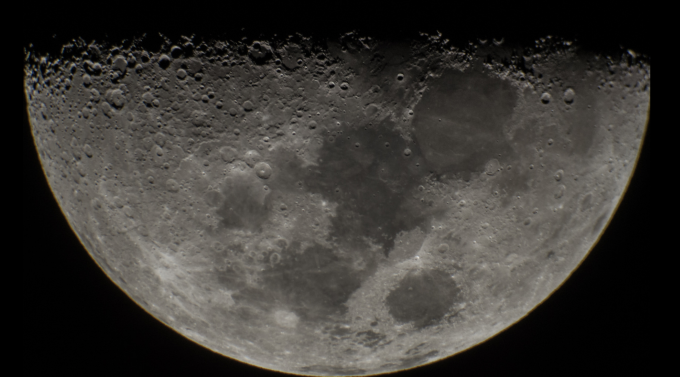
Photograph by Kevin Watson. Used with permission.
The main Moon phases are:
- full - Oct 16
- 3rd quarter - Oct 22
- new - Oct 30
- 1st quarter - Nov 7
dusk planets
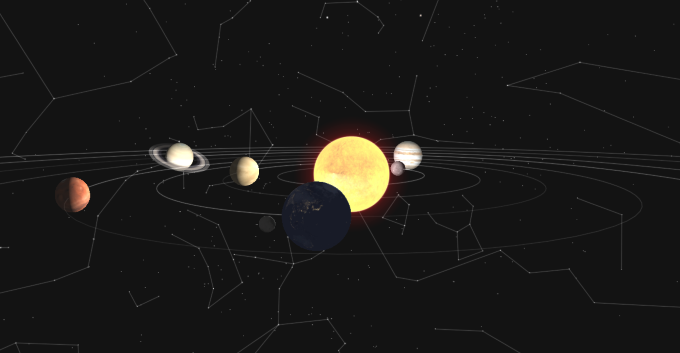
Solar system images produced with the Solar System Scope web site. Note: image not to scale. Not even close.
The planets, in the image above, left of the Sun, are visible at sunset. From the Sun, Venus, Saturn, and Mars.
Venus is moving, from our perspective, away from the Sun. As it draws near to us, orbiting faster than the Earth, it will appear in the telescope to grow in size. It will be low at sunset but very bright. It used to be thought that Venus would only reach magnitude -4 when in fact it will go over -4.5.
Venus will move close to Saturn on October 29. Get out the camera!
The Moon will join Venus and Saturn on November 1 for a pretty view, for 3 nights actually! That should be quite photogenic.
Saturn is in the constellation Ophiuchus, the 13th constellation along the ecliptic. It is one of the few planets currently above the ecliptic (path the Sun, Moon, and planets follows). The Sun is catching up with Saturn, from our vantage, so look while you can. These are your last chances to view the ringed planet.
Mars is further left of Venus and Saturn and continues to move swiftly eastward through Sagittarius. That makes it well-placed for early evening viewing. It is decreasing in brightness and size as we're slowly drawing away. Don't expect exciting views in the telescope. To the eye though it is a wonderful colour.
Watch it, over the course of the evening of October 25, move between the stars chi 1 Sgr and chi 3. They are like goal posts. Then on October 30, watch the red planet slowly move away from double star 53 Sgr.
Consider taking a wide-field picture every night, around the same time, particularly if you can avoid moving the camera. Then you can watch the 4th planet move in a short time lapse.
up at dawn
In the image above, the planets to the right of the Sun, Mercury and Jupiter, are visibile before sunrise.
Elusive Mercury will be visible for a few more days, from October 12, before zipping behind the Sun. It appears, from Earth, to be falling in. This is the best view of year. That's due in part to the angle of the ecliptic in the morning. It is canted high, nearly vertical. Good for all your early-birds.
Also, Mercury appears beside Jupiter.
Jupiter has reappeared to our morning sky after hiding behind the Sun.
Jupiter will make a lovely showing on October 28 with with the Moon and the interesting double star Porrima.
planet in the blue sky
It is fun to try for Venus in the daytime. There is less risk using a telescope or binoculars on Venus when it follows (vs. leads) the Sun. The best opportunities present themselves on November 2 and 3 with the Moon nearby. Stand in the shadow of a building or tree, get out the binoculars, find the faint crescent Moon in the sky, and then look in the appropriate direction for Venus. It will appear as a very small but brilliant point of light.
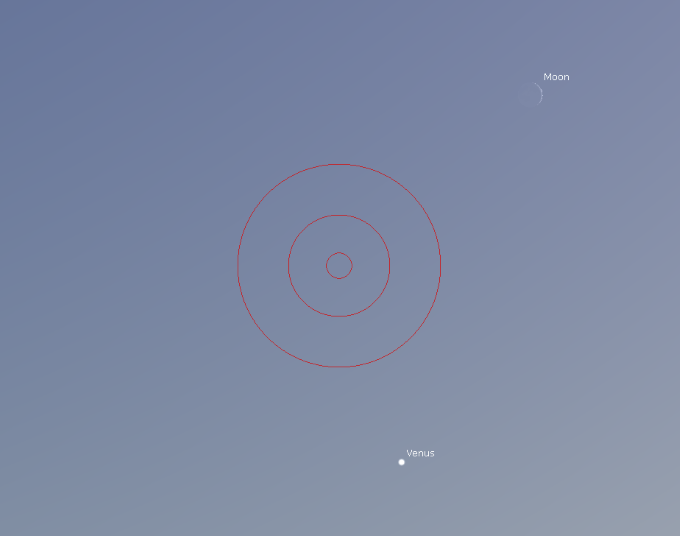
Image from Stellarium. Largest Telrad circle is 4 degrees.
Take away the binoculars and try to spot in with the unaided eye. Use the Moon (or a passing airplane) to help focus your eyes correctly.
Use the image above as a guide. This is for November 2. On November 3, the Moon will have moved down and left of the red circles. Largest Telrad circle is 4 degrees. Binoculars often have a 6 or 7 degree field of view.
blue outer planets

Not to scale.
During your late-night viewing, explore the outer icy worlds.
This is an excellent time to view Uranus. It is high in the sky. More importantly, it will be at opposition on October 15. That is, it is opposite the Earth from the Sun. When we have an opposition of an outer planet, it is close to the Earth. And that means that are as big and bright as they can be. For planets like Mars, surface details are attainable. For the distant planets, we can try for their dim moons!
When Uranus is at opposition, it hovers around magnitude 5 and 6, which is the typical naked eye threshold. So in dark skies, you might spot the seventh planet without a telescope! It is near zeta Psc. Try it!
Uranus appears, under medium to high power in the telescope, as a pale blue disc. Under good conditions, in a large instrument, you should be able to coax out a couple of the distant world's large moons. Titania is magnitude 14.4, Oberon 14.7, and Ariel 14.7. That may mean you need to use a telescope with a 12-inch aperture. Umbriel is 15.3 and Miranda, the innermost, is magnitude 16.9. Tough. Or not possible.
Titania orbits Uranus rapidly at 8.7 days. Bear in mind that the axial tilt of Uranus is extreme (compared to Earth's 23 degrees) at nearly 90. That means the moons appear to move up and down for us (unlike the Jovian moons left-right motion).
This planet is about 20 Astronomical Units (AU) away. One AU is the Earth-Sun distance. Uranus is 20x that! It takes light 2-3/4 hours to travel that distance.
Factoid: On October 24, 1851, William Lassell discovered Umbriel and Ariel.
Neptune recently went through opposition so we're pulling away. The 8th planet usually seems a darker blue than Uranus.
It can reveal it's biggest moon, Triton, under the right conditions. Curiously, Triton is brighter than the moons of Uranus, listed at magnitude 14.0. So even though Neptune is over 29 AU away (that's 4 hours light time), it is easier to see its moon. You may only need a 10-inch 'scope.
Neptune is well-placed in the early evening. It is also up high. It is near the meridian at 9:30 PM on October 30.
elongations of moons
All times EDT. Ontario location. The best time to try to see the faint moons of Uranus or Neptune is when they are widely separation from the host planet or at greatest elongation.
Titania (North or South)
- Oct 20 - 7:12 PM - S
- Oct 25 - 3:40 AM - N
- Nov 2 - 8:43 PM - N
- Nov 7 - 4:05 AM - S
Triton (East or West)
- Oct 23 - 2:03 AM - W
- Oct 26 - 12:36 AM - E
- Oct 28 - 11:07 PM - W
- Oct 31 - 9:39 PM - E
- Nov 3 - 8:10 PM - W
- Nov 6 - 5:41 PM - E
faint comets
There are a couple of comets accessible in small amateur telescopes. These all appear to be fairly faint and without tails.
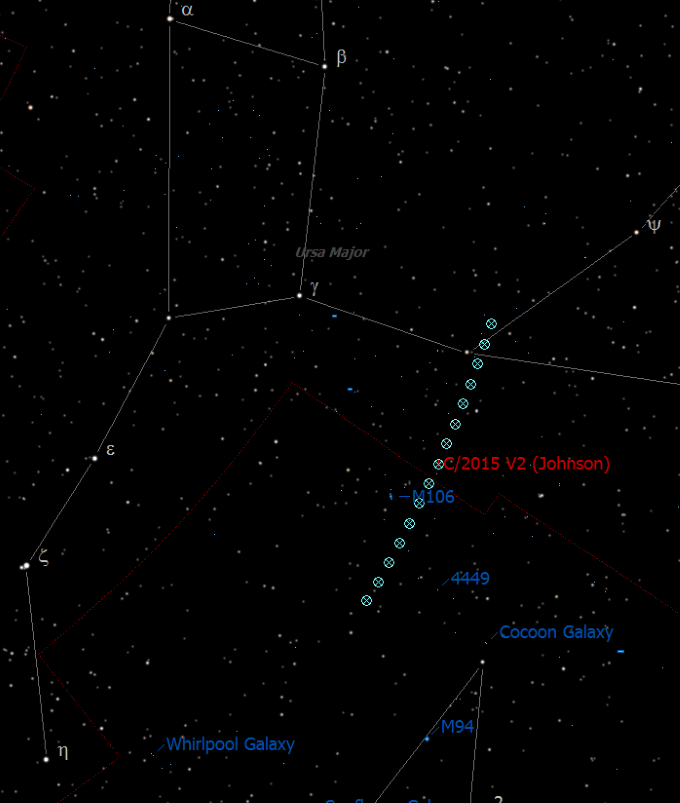
C/2015 V2 (Johnson) is a morning target. It should be visible in a 6-inch telescope. It is in Ursa Major currently and moving toward Canes Venatici. It is said to be brightening.
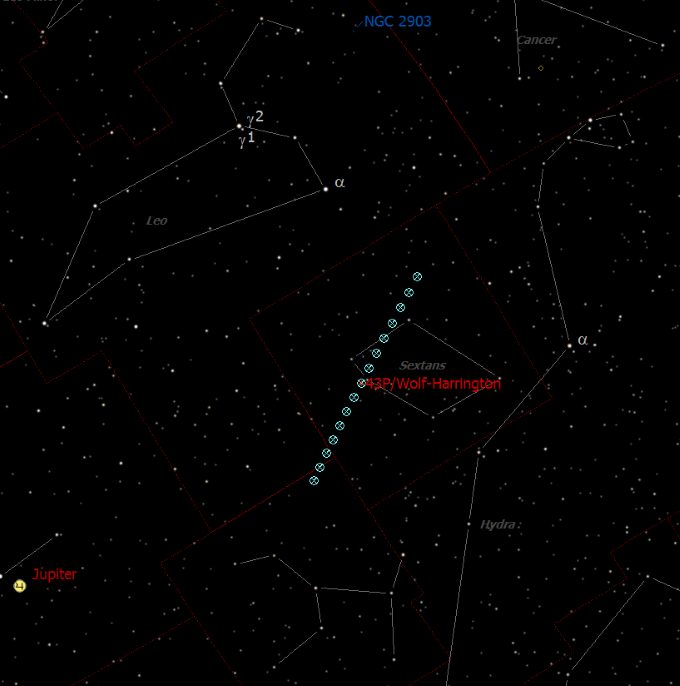
43P/Wolf-Harrington is another morning quarry. It is dimmer and may require an 8-inch instrument. It is in Sextans heading toward Crater.
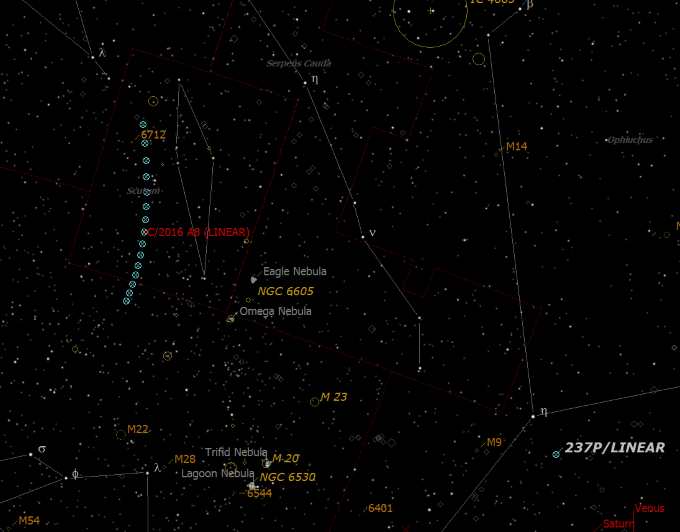
In the early evening, with an 8-inch 'scope, one might try to tag C/2016 A8 (LINEAR) in Scutum. It slowly moves toward the Teapot.
Charts from SkyTools. Comet chasing data from SkyHound.
backyard occultations
There are a couple of occultation opportunities coming up and you might be able to set up in your back yard. All right. Both are tantalizing with stars in the magnitude 10 to 11 range, putting these events within reach of visual observers.
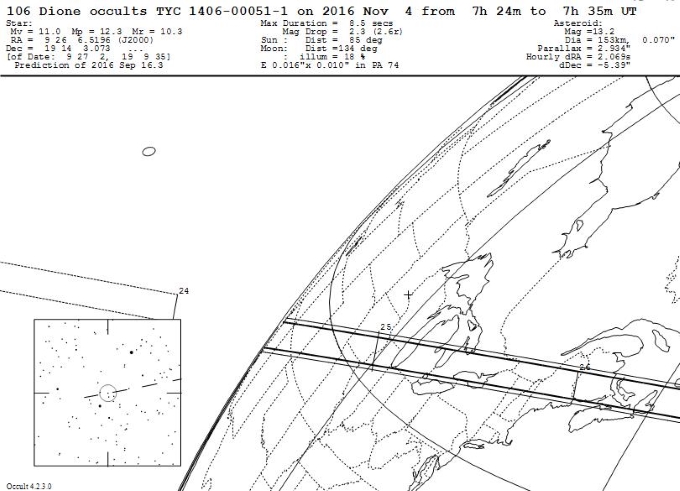
Late Thursday night-early Friday morning, at 3:25, on November 4, asteroid (106) Dione will block the light of a magnitude 11 star for up to 8 seconds. The wide path appears to go over much of south-western Ontario.
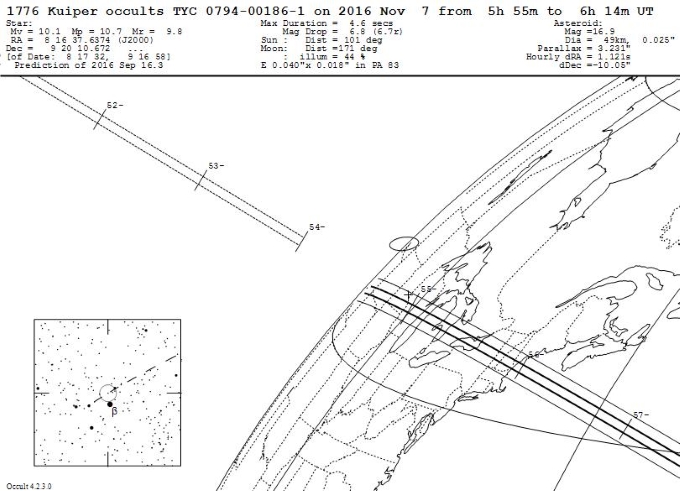
Then, 12:55 AM (just after mignight) on November 7, (1776) Kuiper will occult a mag 10.1 star for about 3.5 seconds. This sports a narrow path; still it goes right over the GTA.
See Steve Preston's occultation web site for more information.
liquid sky
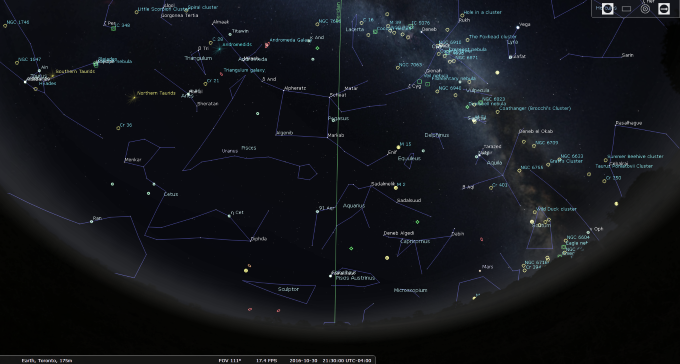
For deep sky targets for the next 4 weeks, consider targets in the water constellations.
When I'm trying to find Aquarius, I usually start with the asterism of the Water Jar. This triad of medium-bright stars is usually easy to spot. The constellation lines are typically drawn down from there: the person holds the jar on their right shoulder and has their left arm outstretched to the west; a stream of water pours from the jar.
Try for a couple of planetary nebulae including the Saturn Nebula (NGC 7009) with its lobes and the large twisting Helix (NGC 7293). The globular cluster designated Messier 2 is attractive. 94 Aqr is a colourful double. Neptune is here. Will be for a while. Pallas, one of the big four asteroids first discovered, is passing through.
Pisces Austrinus, the single fish constellation, is a small somewhat faint collection low to our Ontario southern horizon. But it includes the easily-spotted bright star Fomalhaut. I particularly enjoy seeing alpha PsA as it is known to host exoplanets. I just like the idea that I can see the parent star of a distant solar system with just my eyes.
Pisces, the two-fish zodiacal constellation, is higher up in the sky. Still, it is often challenging to identify with so many faint stars. Locating the Circlet to the west is a good jumping off point. Check out the galaxy Messier 74, the interesting double star 55 Psc, the curious red star 19 Psc. It's a C-class ember. You'll find Uranus within the net.
Cetus, the sea monster, is just below Pisces. I encourage you to take in galaxies M77 (from Chuck Messier, of course) and NGC 936 (one of the RASC Finest NGCs), exploded star NGC 246, and triple star Struve 80 (aka HD 5780). See if you can follow the big asteroid Ceres over a couple of nights. Cetus also hosts the very interesting long-period variable star Mira aka omicron. But it will perhaps be in its dimmest phase when you look.
When constellations are near the meridian, the imaginary line that runs from north-to-south, and directly overhead through the zenith, they are as high as they can be for us. And that can make the DSOs within more pleasing to view, being brighter, and steadier, given we're looking through less air.
Pegasus is one such constellation, nearly overhead in evenings this month. Take in Messier 15, another globular. Enjoy radiant Struve 2991 (also known as HR 8833). See if you can spot some of the individual galaxies in Stephan’s Quintet. With a big 'scope, you might actually note more than five elements.
Andromeda and Triangulum are also high up. Many overlook the galaxy NGC 891. See if you can pick up colour in the Blue Snowball. Speaking of colour, soak in Almach (HR 603). I keep trying to view the faint face-on galaxy M33 naked eye; for some, the Pinwheel galaxy will only appear faintly in a telescope. Open cluster NGC 752 though is easy to spot with the Mark I eyeball. For two-in-the-view, at low or medium power, see if you can split the pairs of doubles, 6 Tri (or STF 227) and HD 13746 (or HIP 10453).
Little Lacerta was featured in Sep/Oct SkyNews magazine so I went lookin'. I found open cluster Collinder 448 (or NGC 7243), a neat multi-star system 8 Lacertae, and even spotted (with an 11-inch big gun) the galaxy MCG 8-40-2.
Sculptor is a small constellation low in the south. It's just about as high up as it will get. Head there to extract galaxy NGC 253. Another item in the RASC Finest list.
And for bonus points, look even further south (assuming you have an exceptional horizon). Can you see a new constellation element, Ankaa (aka HR 99), in the Phoenix?! Only a portion of the unique constellation crosses over the theoretical horizon for Ontario residents. Still I’m gonna try to get the lucida or alpha star.
meteors rising
September represents a lull in meteors (although I've seen a lot of sporadics lately). Did you know that about 100 to 200 tons of material hits the Earth every day? That can make for a lot of random streaks across the sky.
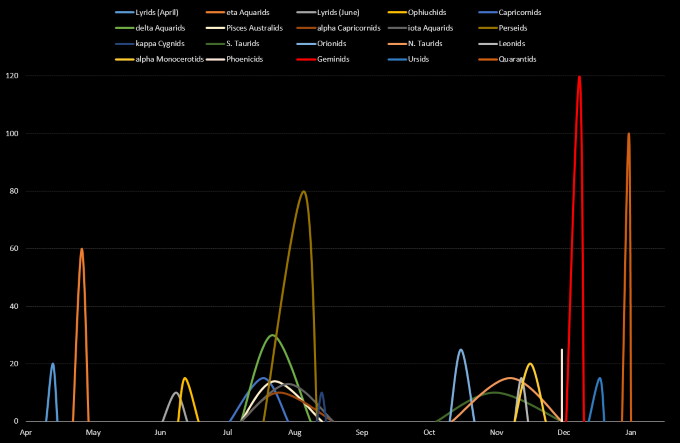
The "big" annual meteor showers are starting up in October, with the Geminids and Quarantids putting on huge shows over the winter.
The Orionid meteor shower is current and continues to November 7. It peaks on October 21 . The zenithal hourly rate is 20 to 25 . It is thought that the source is comet 1P/Halley.
The minor epsilon-Geminid shower peaks on October 18.
Zarya spotting
Meteors are fast and short; the ISS sometimes takes 6 or 7 minutes to cross the sky.
The International Space Station is in its evening phase from the time of reporting until October 20. Fun to watch and fun to photograph. For an extra challenge, try to track it in your telescope. You should be able to see features (like the habitat and science modules) and colours (like the copper solar arrays).
After a couple of weeks, the morning flyovers start--November 5.
Remember to use the Heavens Above web site to predict ISS passes as well as Iridium flares.
I've still not been able to identify the dual flyover (north-east through Ursa Major) I spotted on September 27 at 2:04 AM.
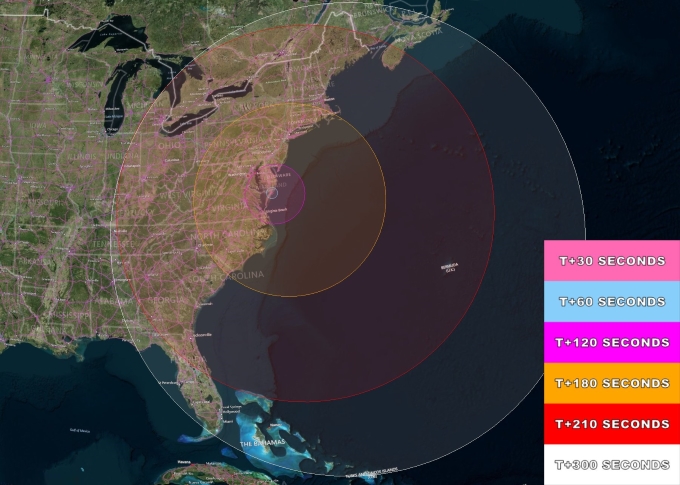
The Orbital ATK Antares cargo vessel, with new rocket engines, is due to launch (tentatively) on October 13 from Wallops Island. This mission, OA-5, to deliver supplies to the ISS, is the first in about 2 years, since their major malfunction. Night-time launches from the Virginia facility are sometimes visible all the way into Ontario!
UPDATE! Due to hurricane Nicole, the launch has been pushed to Sunday. See SpaceFlightNow.com for more information.
I spotted in Ron Baalke's big list of upcoming events the ISPCS conference. This is the International Symposium for Personal and Commercial Spaceflight. It runs over October 12 and 13 in Las Cruces, New Mexico. The word "personal" gave me pause. Wow. Imagine a world where an individual, a person, can decide, "Hey, honey, why don't we and the kids pop over the Mars for the month, eh? I hear the colours are spectacular right now." Personal space flight...
probing
The ESA ExoMars craft is near its destination with an expected separation of the orbital probe and landing vessel on October 16.
See the ExoMars site for more information.
The NASA Juno probe is safely in orbit around Jupiter. The giant planet's gravity accelerated the craft to 74 km/s or 266 000 km/h making it, for a time, the fastest human-made object. It successfully braked, using its engine, and some Kepler mathematics, to enter a highly elliptical 53-day orbit. The planned burn on October 19 will decrease the height of the orbit and change to a 14-day frequency, for the main science campaign. Jupiter's incredible radiation and magnetism is expected to destroy a number of the instruments after a few orbits.
See the Juno site for more information.
The ESA Gaia probe is working well. The incredible data set is being integrated into systems already so to improve accuracy and precision.
See the Gaia site for more information.
recap
Here's a quick summary of the big events for the sky this month.
Oct
- now - Mercury (morning)
- 15 - Uranus at opposition (but the Moon's in the way!)
- 16 - bright ISS flyover
- 19 - Moon very near Aldebaran
- 27 - Saturn, Venus, Antares in a line
- 28 - Moon, Jupiter, Porrima together (morning)
- 29 - Venus near Saturn
- 31 - dark sky observing party window opens (first clear night)
Nov
- 2 - Moon near Venus and Saturn
- 2 & 3 - day time Venus near Moon
- 4 - Moon between Venus and Mars
- 5 - fall back
- 6 - Lunar X
celebrate
Mr Carl Sagan’s birthday was on November 9. Surely he was one of the nicest human beings to walk the pale blue dot.
§
Be seeing you. Contact Blake Nancarrow (astronomy at computer-ease dot com) for errors, omissions, questions.

